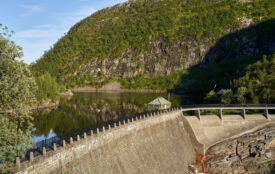Which factors trigger leaf die-off in autumn?
Researchers at ETH Zurich have identified a self-regulating mechanism in European deciduous trees that limits their growing-season length: Trees that photosynthesise more in spring and summer lose their leaves earlier in autumn.
Leaves of temperate deciduous trees glow in all their yellow and red glory just before falling, signalling that autumn has come. This process, called leaf senescence, allows trees to prepare for the coming winter by suspending their growth and extracting nutrients from the foliage. In the trees’ phenological cycle, leaf senescence marks the end of the productive period during which they absorb CO2 through photosynthesis.
Global warming has resulted in longer vegetation periods in recent years, with spring leaf emergence in European trees happening about two weeks earlier than 100 years ago and autumn senescence about six days later. It is generally expected that senescence will continue to be delayed in a warming climate, increasing the amount of carbon captured by these plants under climate change.
However, researchers at ETH Zurich have now come to the opposite conclusion. In a study published in the journal Science, they have demonstrated a self-regulating mechanism that limits the productive period. Increased photosynthesis in spring and summer leads to earlier senescence, which could result in earlier leaf fall in autumn.
Sink limitation as senescence driver
“Accurate forecasts of the growing season of trees have previously been difficult, as the drivers of leaf senescence have not been well understood,” says Constantin Zohner, study leader and senior scientist at ETH Zurich’s Crowther Lab.
Until now, scientists have generally assumed that, after the summer ends, the autumnal declines in temperature and day length are the main cues determining the timing of leaf senescence. Some studies additionally indicated that leaf emergence in spring has an effect on leaf death in autumn. “But because the importance of these mechanisms remained unclear, phenological models were at best only partly able to take such effects into account,” says the biologist.
Zohner suspected that the link between spring and autumn phenology can be explained by photosynthetic activity – or more precisely, the phenomenon of carbon sink limitation. In this hypothesis, scarce soil nutrients such as nitrogen, among other things, limit the quantity of CO2 that a plant can absorb during the season. The more carbon trees absorb in spring and sumer, the earlier leaf senescence should therefore begin.
This role of photosynthesis in the control of leaf senescence has long been known for example in crops, but has never been tested in trees. This is what motivated ETH Zurich researchers to investigate the drivers of autumn phenology with a combined approach of field observations, laboratory tests and modelling.

Strong effect of photosynthesis
Long-term observations of six European deciduous tree species over the last six decades formed the basis of the study. Using this data, Zohner’s team tested the relative influence of various factors on the timing of autumn senescence, including leaf emergence in spring, seasonal photosynthesis, CO2 concentration, temperature and precipitation.
In addition, the researchers also performed a set of experiments with saplings in climate chambers and outdoors. This enabled them to isolate the effects of temperature, daylight and CO2 content that drive the correlation between photosynthesis and leaf senescence.
The long-term observations revealed a strong effect of photosynthesis: in years with increased photosynthesis in spring and summer, leaf senescence began earlier, with each ten percent increase in photosynthetic activity advancing leaf senescence by eight days. The experiments supported these findings.
A new autumn senescence model
“Our analyses suggest that seasonal photosynthesis, autumn temperatures and day length are the key drivers of senescence,” says lead author Deborah Zani in explaining the forces involved. “Several other factors, such as atmospheric CO2 concentrations, summer temperatures, light levels and precipitation also appear to influence senescence, but only indirectly through affecting photosynthesis.”
Warmer autumns under climate change therefore tend to postpone senescence. This effect, however, is counteracted by increasing photosynthesis in spring and summer through rising CO2 concentrations, warmer summer periods and earlier leaf emergence.
Zani and Zohner developed a new model of autumn phenology that takes all factors into account according to their relevant weight. This model enabled the researchers to predict the timing of autumn senescence over the last six decades with up to 42 percent more accuracy compared to previous models.
The authors then used this model to generate updated forecasts of leaf senescence timing over the rest of the century and the results were quite unexpected. Until now it had been expected that senescence would occur two to three weeks later by the end of the century. “Our new model suggests the contrary: if photosynthesis continues to increase, leaves will senesce three to six days earlier than they do today” says Zani. “This means that the growing season will be extended by only 8 to 12 days by the end of the century, around two to three times less than we previously thought”, Zani adds. She conducted the data analysis and modelling as part of her Master’s thesis at the Crowther Lab.
Impact on carbon balance
In their study, the researchers made use of data from the Pan European Phenology Project, evaluating a total of 434,000 phenological observations at 3,800 locations in central Europe between 1948 and 2015. Six representative species were studied: European horse chestnut, silver birch, European beech, European larch, English oak and rowan.
The authors see their study as evidence that temperate forests have a limited capacity to absorb CO2: “Seasonal CO2 uptake will probably increase to a lesser degree with rising temperatures than older models predicted,” says Zohner. The ETH Zurich researchers now want to better understand carbon sink limitation in the forests of the earth.
- Zani D, Crowther TW, Mo L, Renner S, Zohner CM. Increased growing-season productivity drives earlier autumn leaf senescence in temperate trees. Science (2020), 26 November 2020, doi: 10.1126/science.abd8911








